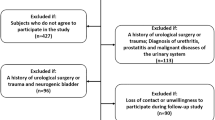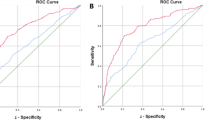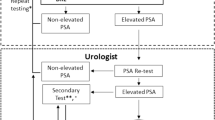Abstract
Increasing prostate volume contributes to urinary tract symptoms and may obscure prostate cancer detection. We investigated the association between obesity and prostate volume, prostate-specific antigen (PSA) and PSA density among 753 men referred for prostate biopsy. Among men with a negative biopsy, prostate volume significantly increased approximately 25% from the lowest to highest body mass index (BMI), waist or hip circumference or height categories. PSA was 0.7 ng/ml lower with a high waist-to-hip ratio. These associations were less consistent among subjects diagnosed with high-grade prostatic intraepithelial neoplasia or cancer. Our data suggest that obesity and height are independently associated with prostate volume.
This is a preview of subscription content, access via your institution
Access options
Subscribe to this journal
Receive 4 print issues and online access
$259.00 per year
only $64.75 per issue
Buy this article
- Purchase on Springer Link
- Instant access to full article PDF
Prices may be subject to local taxes which are calculated during checkout
Similar content being viewed by others
References
Isaacs JT, Coffey DS . Etiology and disease process of benign prostatic hyperplasia. Prostate 1989; 2: 33–50.
Flegal KM, Carroll MD, Ogden CL, Johnson CL . Prevalence and trends in obesity among US adults, 1999–2000. J Am Med Assoc 2002; 288: 1723–1727.
Wannamethee SG, Shaper AG, Morris RW, Whincup PH . Measures of adiposity in the identification of metabolic abnormalities in elderly men. Am J Clin Nutr 2005; 81: 1313–1321.
Dahle SE, Chokkalingam AP, Gao YT, Deng J, Stanczyk FZ, Hsing AW . Body size and serum levels of insulin and leptin in relation to the risk of benign prostatic hyperplasia. J Urol 2002; 168: 599–604.
Zucchetto A, Tavani A, Dal Maso L, Gallus S, Negri E, Talamini R et al. History of weight and obesity through life and risk of benign prostatic hyperplasia. Int J Obesity 2005; 29: 798–803.
Hammarsten J, Hogstedt B, Holthuis N, Mellstrom D . Components of the metabolic syndrome – risk factors for the development of benign prostatic hyperplasia. Prostate Cancer Prostatic Dis 1998; 1: 157–162.
Soygur T, Kupeli B, Aydos K, Kupeli S, Arikan N, Muftuoglu YZ . Effect of obesity on prostatic hyperplasia: its relation to sex steroid levels. Int Urol Nephrol 1996; 28: 55–59.
Sarma AV, Jaffe CA, Schottenfeld D, Dunn R, Montie JE, Cooney KA et al. Insulin-like growth factor-1, insulin-like growth factor binding protein-3, and body mass index: clinical correlates of prostate volume among Black men. Urology 2002; 59: 362–367.
Freedland SJ, Platz EA, Presti Jr JC, Aronson WJ, Amling CL, Kane CJ et al. Obesity, serum prostate specific antigen and prostate size: implications for prostate cancer detection. J Urol 2006; 175: 500–504.
Parsons JK, Carter HB, Partin AW, Windham BG, Metter EJ, Ferrucci L et al. Metabolic factors associated with benign prostatic hyperplasia. J Clin Endocrinol Metab 2006; 91: 2562–2568.
Schuurman AG, Goldbohm RA, Dorant E, van den Brandt PA . Anthropometry in relation to prostate cancer risk in the Netherlands Cohort Study. Am J Epidemiol 2000; 151: 541–549.
Presti JC, Lee U, Brooks JD, Terris MK . Lower body mass index is associated with a higher prostate cancer detection rate and less favorable pathological features in a biopsy population. J Urol 2004; 171: 2199–2202.
Kulkarni GS, Al-Azab R, Lockwood G, Toi A, Evans A, Trachtenberg J et al. Evidence for a biopsy derived grade artifact among larger prostate glands. J Urol 2006; 175: 505–509.
Fontaine KR, Heo M, Allison DB . Obesity and prostate cancer screening in the USA. Public Health 2005; 119: 694–698.
Fowke JH, Signorello LB, Underwood W, Ukoli FA, Blot WJ . Obesity and prostate cancer screening among African–American and Caucasian men. Prostate 2006; 66: 1371–1380.
Baillargeon J, Pollock BH, Kristal AR, Bradshaw P, Hernandex J, Basler J et al. The association of body mass index and prostate-specific antigen in a population-based study. Cancer 2005; 103: 10920–11095.
Kristal AR, Chi C, Tangen C, Goodman PJ, Etzioni R, Thompson IM . Associations of demographic and lifestyle characteristics with prostate-specific antigen (PSA) concentration and rate of PSA increase. Cancer 2005; 106: 320–328.
Farnsworth WE . Estrogen in the etiophathogenesis of BPH. Prostate 1999; 41: 263–274.
Coffey DS . Similarities of prostate and breast cancer: evolution, diet, and estrogens. Urology 2001; 57: 31–38.
Bray I, Gunnell D, Holly JM, Middleton N, Smith GD, Martin RM . Associations of childhood and adulthood height and the components of height with insulin-like growth factor (IGF) levels in adulthood: 65 year follow-up of the Boyd Orr cohort. J Clin Endocrinol Metab 2006; 91: 1382–1389.
Rhodes T, Girman CJ, Jacobsen SJ, Roberts RO, Guess HA, Lieber MM . Longitudinal prostate growth rates during 5 years in randomly selected community men 40–79 years old. J Urol 1999; 161: 1174–1179.
Calle EE . Invited commentary: do anthropometric measures predict risk of prostate cancer? Am J Epidemiol 2000; 151: 550–553.
Fowke JH, Signorello LB, Chang SS, Matthews CE, Buchowski MS, Cookson MS et al. Effects of obesity and height on PSA and percent free PSA levels among African–American and Caucasian men. Cancer 2006; 107: 2361–2367.
Werny DM, Saraiya S, Blackman D . Prostate-specific antigen levels in diabetics and non-diabetics from the National Health and Nutrition Examination Survey, 2001–2002. Fourth Annual AACR Frontiers in Cancer Prevention Conference.
Kaaks R, Lukanova A, Rinaldi S, Biessy C, Soderberg S, Olsson T et al. Interrelationships between plasma testosterone, SHBG, IGF-I, insulin and leptin in prostate cancer cases and controls. Eur J Cancer Prev 2003; 12: 309–315.
Sakr WA, Grignon DJ, Crissman JD, Heilbrun LK, Cassin BJ, POntes JJE et al. High grade prostatic intraepithelial neoplasia (HGPIN) and prostatic adenocarcinoma between the ages of 20–69: an autopsy study of 249 cases. In Vivo 1994; 8: 439–444.
Ogden CL, Fryar C, Carroll MD, Flegal KM . Mean body weight, height, and body mass index, United States 1960–2002. Advance Data from Vital and Health Statistics: National Center for Health Statistics, vol. 347, 2004, pp 1–20.
Freedland SJ, Isaacs WB, Platz EA, Terris MK, Aronson WJ, Amling CL et al. Prostate size and risk of high-grade, advanced prostate cancer and biochemical progression after radical prostatectomy: a search database study. J Clin Oncol 2005; 23: 7546–7554.
Acknowledgements
Funding was provided by the NIH CA98348, DAMD17-02-1-0139 and M01 RR00095 to the Vanderbilt General Clinical Research Center. We are grateful to Dr C Eckstein and the clinical and nursing staff at the Urology Associates, the Veterans Administration and Vanderbilt, for essential collaboration on this project.
Author information
Authors and Affiliations
Corresponding author
Additional information
Conflict of Interest
The authors state no conflict of interest.
Rights and permissions
About this article
Cite this article
Fowke, J., Motley, S., Cookson, M. et al. The association between body size, prostate volume and prostate-specific antigen. Prostate Cancer Prostatic Dis 10, 137–142 (2007). https://doi.org/10.1038/sj.pcan.4500924
Received:
Revised:
Accepted:
Published:
Issue Date:
DOI: https://doi.org/10.1038/sj.pcan.4500924
Keywords
This article is cited by
-
A combined treatment with selective androgen and estrogen receptor modulators prevents bone loss in orchiectomized rats
Journal of Endocrinological Investigation (2022)
-
Correlation between body mass index and prostate volume in benign prostatic hyperplasia patients undergoing holmium enucleation of the prostate surgery
BMC Urology (2021)
-
The correlation between obesity and prostate volume in patients with benign prostatic hyperplasia at Charlotte Maxeke Johannesburg Academic Hospital
African Journal of Urology (2021)
-
Tall height and obesity are associated with an increased risk of aggressive prostate cancer: results from the EPIC cohort study
BMC Medicine (2017)
-
The impact of obesity on the predictive accuracy of PSA in men undergoing prostate biopsy
World Journal of Urology (2014)



